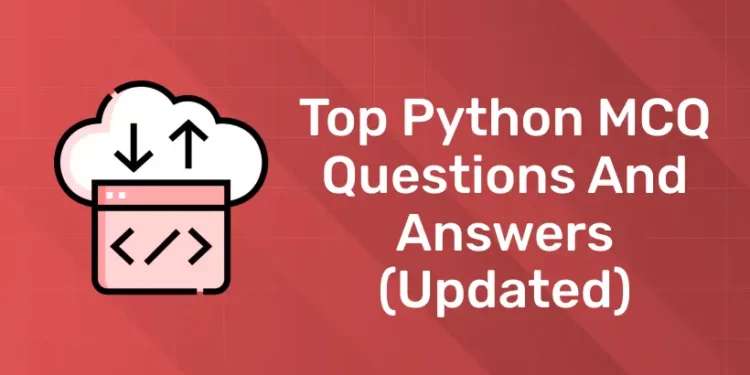Table of Contents
Python is a high-level programming language that comes with dynamic binding and high-level built-in data structures. It is an object-oriented programming language that is interpreted. Python MCQ stands out among other programming languages because of its simple syntax, which is easy to write and comprehend for both novices and experts. Python’s wide range of applications and library support make it possible to create incredibly flexible and scalable software and products on top of it in the real world.
You can find a large variety of Python MCQ (Multiple Choice Questions) covering a broad spectrum of Python programming subjects in this article. These Python MCQ (multiple-choice questions) cover basic to advanced subjects, letting you assess your understanding of concepts including operators, data types, functions, grammar, and best practices.
Experience the power of our python programming course with a free demo – enroll now!
Introduction
Guido van Rossum created Python, which was initially made available on February 20, 1991. Being interpretive in nature, it is one of the most popular and frequently used programming languages, offering flexibility in integrating dynamic semantics. It has a relatively straightforward syntax and is free and open-source. Python learning is made easier for developers as a result. And Python is mostly used for general-purpose programming, but it can also support object-oriented programming.
The Python is becoming more and more popular because of its ease of use and capacity to accomplish more tasks with fewer lines of code. Python’s ability to enable strong calculations utilising strong libraries makes it useful in a variety of other disciplines, including machine learning, artificial intelligence, web development, and web scraping.
Why Learn Python
Python is a high-level, free, open-source programming language with an easy-to-learn syntax that is perfect for developers. The most recent version of the Python programming language, version 3, is utilized in machine learning applications, web development, and every other cutting-edge software industry technology.
1. Data Science
The majority of data scientists use Python as their programming language of choice. These days, data is used in every job and is essential to its operation, whether it be in marketing, software development, or IT operations. Python gained popularity in the data sector with the advent of “Numpy” and “Pandas.” Along with handling statistical, tabular, and matrix data, Python also uses libraries like “Matplotlib” and “Seaborn” to visualize it.
2. Easy to Learn
Python is a simple language to learn. This is primarily due to the language’s similarity to English. The syntax of Python is defined by a small number of special circumstances and rules. It’s safe to argue that Python places more emphasis on your intended use of the code than on linguistic nuances. Python is easily mastered by everyone. This programming language’s readability and speed are other appealing features.
3. Cross-Platform and Open Source
This language has been available as open source and cross-platform for more than 20 years. Python code is compatible with all operating systems, including Windows, Linux, and MacOS. Python’s support for decades of bug-squashing and kink-straightening assures that its code functions as intended every time the user runs it, which is another amazing feature of the language.
4. Versatile Language and Platform
Python’s continued relevance stems from its ability to be used in a wide range of operations and software development scenarios. It can be used to manage both local and cloud infrastructure, work with SQL databases, create custom functions for Hive & Pig, support object-oriented design, or even create simple user tools.
5. Vast Libraries
Python is supported via PyPI, which offers the user access to over 85,000 Python scripts and modules. Users can access pre-packaged functionality in their local Python environment by using these modules.It can handle a wide range of issues, including machine vision, sentiment analysis, and complex data analytics tasks like creating REStful web services.
6. Flexibility
When combined with other programming languages, Python offers a number of strong applications. Here are some details about them:
- IronPython is compatible with C# and.Net.
- An instance using C: CPython
- Ruby and Python together: RubyPython
- Python that is combined with Java:
- Python coded with PyObjc, an Objective C toolbox
7. High Salary
When compared to other professionals in the business, Python engineers receive a somewhat better income. The average yearly salary for a Python developer INR is approximtely up to 951426 INR. Python has a great earning potential because it is widely used in many different areas, such as technology, healthcare, finance, and more.
8. Artificial Intelligence
In the field of artificial intelligence (AI), Python excels. Python’s libraries, such as Keras and TensorFlow, make it possible to develop intricate deep learning and machine learning algorithms. Python’s NLTK and spaCy are excellent at tasks like sentiment analysis and language translation, which is why these libraries are commonly used in AI applications like natural language processing (NLP).
9. Testing Framework
For established businesses, this language is a great tool for verifying concepts or goods. Numerous testing frameworks for troubleshooting and quick workflows are built into Python. Its modules and tools, such Splinter and Selenium, function to simplify tasks. Python is also capable of supporting cross-browser and cross-platform testing thanks to frameworks like Robot and PyTest.
10. Web Development
Python offers many frameworks for building websites and web applications. Python offers many frameworks for creating web applications. Python is used to write popular frameworks like Django, Flask, and Pylons, which are known for their speedier and more reliable code. Users can execute web scraping—that is, obtaining information from other websites—by using Python.
Experience the power of our python programming course with a free demo – enroll now!












